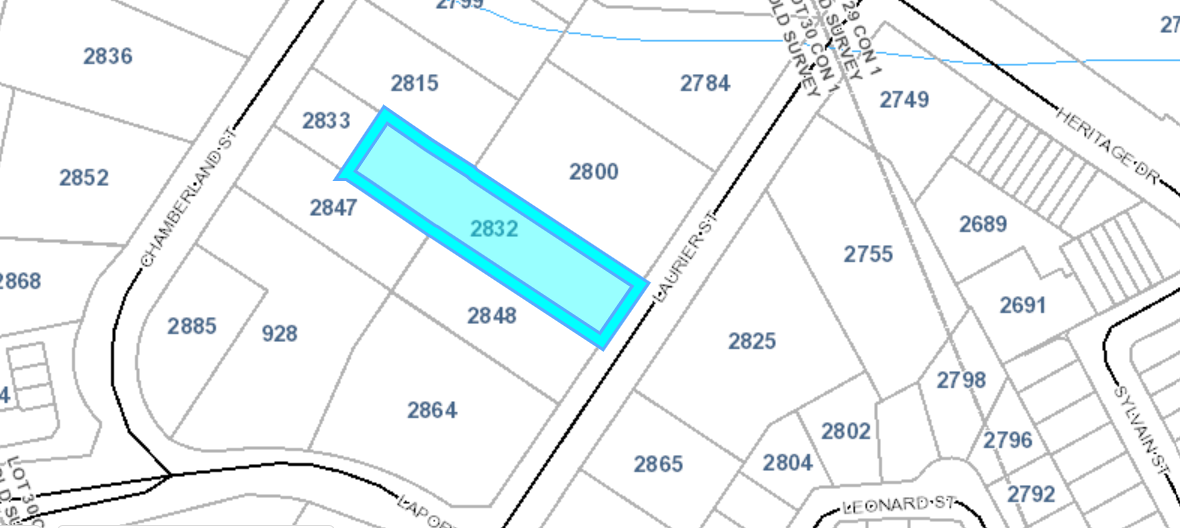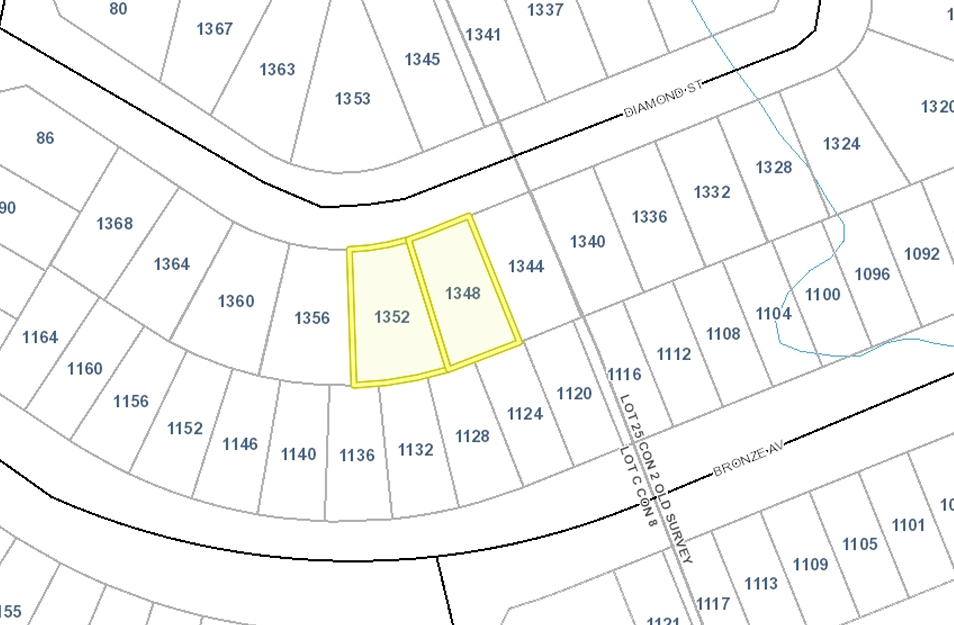Comité de dérogation
Mandat du comité
Le Comité de dérogation est un tribunal quasi judiciaire nommé par le Conseil municipal et qui exerce ses activités indépendamment de l'administration municipale, conformément à la Loi sur l'aménagement du territoire.
En général, le Comité de dérogation se réunit une fois par mois en vue d'examiner notamment :
- Les demandes de dérogations mineures à une disposition du Règlement de zonage;
- L'agrandissement d'un bâtiment ou des changements aux utilisations non conformes existantes aux termes du Règlement de zonage;
- Les demandes d'autorisation de morcellement d'un terrain ou des demandes concernant toute entente, toute hypothèque ou tout bail qui s'applique pour plus de 21 ans;
- Les demandes de validation de titre et de pouvoir de vente.
Le Comité de dérogation et son processus d'examen des demandes sont distincts et indépendants des autres processus municipaux d'approbation des projets d'aménagement. Il peut donc arriver que les différents processus d'approbation se déroulent simultanément. Consultez la section développement et planification pour plus d'informations.
Structure du Comité
Le Comité est composé de 4 membres du conseil et deux membres du public.
Avant de soumettre une demande, consultez le Guide sur les dérogations mineures et les permissions, et communiquez avec le Service de l'aménagement du territoire pour plus d'informations au 613-446-6022 poste 0.
| Guide sur les dérogations mineures et les permissions |
1.0 IntroductionLe présent document vise à fournir au public, aux propriétaires fonciers, aux constructeurs et à la municipalité des lignes directrices pour faciliter la préparation, la soumission, l’examen et l’approbation de nouveaux projets d’aménagement dans la Cité de Clarence-Rockland. Une « dérogation mineure » est une modification mineure à une norme de rendement établie dans le règlement de zonage de la Cité, accordée par le Comité de dérogation. La demande de dérogation mineure est une méthode pour demander un redressement lorsque les difficultés ou les circonstances rendent difficile le respect des normes établies dans le règlement de zonage. Les dérogations mineures ne peuvent ajouter une utilisation interdite en vertu du règlement de zonage et qui nécessiterait une « modification du règlement de zonage ». Il est à noter que dans certains cas, une « permission » en vertu de l’article 45(2) de la Loi sur l’aménagement du territoire (pour un changement d’utilisation et des agrandissements non conformes) pourrait être envisagée dans le cadre de ce processus. Ces lignes directrices visent à aider le promoteur à comprendre les exigences de la Cité et les types de questions qui seront examinées aux fins d’approbation. 2.0 Processus d’approbation des dérogations mineures2.1 Principales étapes2.1.1 Consultation préalable avec le personnel du Service de l’aménagement du territoire de la CitéLes auteurs de demande devraient, avant de soumettre toute demande, mener une consultation préalable auprès d’un urbaniste municipal. Au cours de la rencontre de consultation préalable, l’urbaniste informera l’auteur de la demande des dérogations requises, et s’il est d'avis que les dérogations demandées satisferaient aux quatre critères. L’auteur de demande peut également profiter de la rencontre de consultation préalable pour poser toute question au sujet du processus de dérogation mineure ou de permission, et demander de l’aide pour remplir le formulaire de demande. 2.1.2 Soumission d’une demande complèteL’auteur de la demande doit soumettre une demande complète, incluant une lettre d’accompagnement ou une justification urbanistique, les renseignements requis durant la réunion de consultation préalable (plan d’arpentage à jour, plan d’implantation, élévations du bâtiment, etc.), les frais requis et une copie de l’acte de propriété. La demande sera ensuite examinée par le secrétaire-trésorier pour s’assurer qu’elle est complète et que tous les renseignements requis ont été fournis. 2.1.3 Distribution de la demandeUne fois la demande jugée complète, et au moins 10 jours avant la réunion, le secrétaire-trésorier du Comité de dérogation enverra un avis de la demande aux voisins situés à moins de 60 mètres de la propriété visée, ainsi qu’à toute personne ou tout organisme public qui en a fait la demande par écrit. Un panneau d’avis sera également placé sur la propriété par une compagnie et sera retiré par celle-ci après la réunion publique. La demande sera également distribuée aux organismes prescrites et aux services de la Cité afin d’obtenir des commentaires et des conditions à prendre en considération au moment de formuler une recommandation sur la demande. 2.1.4 Approbation par le Comité de dérogationLe Comité de dérogation a le pouvoir d’approbation pour les autorisations, les dérogations mineures et les permissions. Le Comité examine attentivement tous les aspects de la demande, notamment :
Il est à noter qu’en plus de ces quatre critères, toutes les décisions d’aménagement doivent également être conformes à la déclaration de principes provinciale. Un rapport sera préparé par un urbaniste municipal et présenté à la réunion publique, suivi d’une recommandation au Comité selon que les préoccupations ont été ou puissent être traitées. Si la demande est approuvée, le Comité de dérogation pourra imposer ou supprimer des conditions dans le cadre de la décision. 2.1.5 Avis de décisionUn avis de décision sera envoyé par la poste à l’auteur de la demande (ainsi qu’à toute personne qui a demandé par écrit de recevoir l’avis de décision ou qui a fourni des commentaires écrits) dans les 10 jours suivant la date à laquelle le Comité de dérogation a pris une décision. Remarque: Il y a une période d’appel de 20 jours suivant la décision. 2.1.6 Décision définitiveSi aucun appel n’est interjeté avant la fin de la période d’appel de 20 jours, la décision est définitive et exécutoire. 2.2 Délais de traitement1. Avis de demande complète et avis public
2. Approbation par le Comité de dérogation
3. Avis de décision
4. Décision définitive
Le délai de traitement total, de la présentation d’une demande complète à la décision définitive, est d’environ 6 à 10 semaines, en supposant qu’il n’y a pas d’appel devant le Tribunal d’appel de l’aménagement local. 3.0 Frais3.1 Frais de demande
350 $ par demande * Un rabais de 10 % est appliqué si un autre type de demande est soumis en même temps (par exemple, autorisation) Pour toute question ou pour obtenir de plus amples renseignements : Service des infrastructures et de l’aménagement, Cité de Clarence-Rockland 1560 rue Laurier Rockland (Ontario) K4K 1P7 Téléphone : 613 446-6022 Télécopieur : 613 446-1497 www.clarence-rockland.com Département d’Urbanisme et de Foresterie, Comtés unis de Prescott et Russell 59 rue Court, C.P. 304 L’Original (Ontario) K0B 1K0 Téléphone : 613 675-4661 Télécopieur : 1-800-667-6307 poste 7101 Courriel : urbanisme@prescott-russell.on.ca www.prescott-russell.on.ca Conservation de la Nation Sud 38 rue Victoria, C.P. 29 Finch (Ontario) K0C 1K0 Téléphone : 613 984-2948, sans frais : 1-877-984-2948 Télécopieur : 613 984-2872 Courriel : info@nation.on.ca www.nation.on.ca |
Appel d'une décision du Comité
Toute décision du Comité de dérogation peut faire l'objet d'un appel au Tribunal d'appel de l'aménagement local (TAAL), moyennant certains frais. L'appel doit être déposé dans les 20 jours qui suivent la décision et comprendre les motifs ainsi que le paiement des frais à l'ordre du ministre des Finances de l'Ontario.
Seuls les particuliers, les sociétés et les organismes publics peuvent en appeler des décisions devant le TAAL. Une association ou un groupe ne peut déposer un avis d'appel. Cependant, un tel avis peut être déposé au nom d'une association ou d'un groupe par une personne qui en fait partie.
On peut obtenir plus d'information au sujet du Tribunal d'appel de l'aménagement local et du processus d'appel en consultant le site Web de la Commission des affaires municipales de l'Ontario
| Procédure de rencontre virtuelle |
|
Les réunions du Comité de dérogation de la Cité de Clarence-Rockland se déroulent en format virtuel via Zoom.
Comment regarder une réunionSi vous avez l’intention de simplement écouter et suivre la réunion vous devez remplir cette demande et un lien à la rencontre vous sera envoyé ou appeler le département du développement communautaire au 613-446-6022, poste 2285. Les demandes doivent être soumise à 16h30 deux jours avant la date de la réunion. Soyez avisé qu’il ne sera pas possible de partager vos commentaires à la réunion si cette option est choisi.
Comment fournir des commentaires au comitéSoumettre des commentaires par écrit :
Participation à l'audience publique virtuelle Zoom par téléphone ou ordinateur/smartphone/tablette
Si vous avez l’intention de faire une présentation ou de fournir des commentaires oraux à l’un des comités vous devez remplir une demande de délégation ou appeler le département du développement communautaire au 613-446-6022, poste 2285. Les demandes doivent être soumise à 16h30 deux jours avant la date de la réunion.
Dès que nous recevrons votre demande de délégation, nous confirmerons votre présence le prochain jour ouvrable et vous fournirons les instructions pour participer* à la réunion publique.
Les informations que vous choisissez de divulguer dans votre correspondance seront utilisées pour recueillir votre point de vue sur la ou les questions pertinentes afin de permettre au Comité de prendre sa décision sur cette question. Ces informations feront partie du dossier public.
Si vous ne faites pas de délégation à la réunion publique ou n'exprimez pas votre point de vue par écrit, le comité peut formuler une recommandation en votre absence et peut recommander des modifications de la proposition.
Procédures de la réunion
La décision
Une fois que tous les commentaires auront été reçus, le président amènera le dossier " en comité " et aucun autre commentaire ne sera permis, sauf si le président ou un membre du comité pose une question.
Le président et les membres annonceront leur recommandation lors de la réunion publique.
Le Comité peut reporter une demande, mais seulement si les circonstances le justifient.
Pour recevoir une copie de la décision, veuillez en faire la demande au Département du développement communautaire à l'adresse zoning_zonage@clarence-rockland.com ou en téléphonant au 613-446-6022, poste 2285, en fournissant les renseignements suivants : votre nom, votre adresse, votre adresse électronique, la date de l'audience, le numéro de dossier et l'adresse de la propriété visée.
Les personnes sont également encouragées à envoyer une correspondance écrite si elles ont des questions ou des préoccupations qu'elles souhaitent partager.
|
Prochaine réunion : le 7 mai 2025
| Filière : D-13-25-04 |
|
PROPRIÉTAIRE : 9444122 Canada Inc. EMPLACEMENT DE LA PROPRIÉTÉ : 2832, rue Laurier, Rockland
BUT ET EFFET DE LA DEMANDE : Duquette Électrique Ltée a demandé, pour le propriétaire, une dérogation mineure afin de reconnaître une couverture de lot de 56% au lieu de 50% et un recouvrement paysager de 9,5% au lieu de 10% par rapport à la superficie du lot.
DATE DE LA RÉUNION PUBLIQUE : PRENEZ AVIS QUE le Comité de dérogation de la Cité de Clarence-Rockland tiendra une audience publique virtuellement sur ZOOM le mercredi, 7 mai 2025 à 17h00, afin d'entendre la demande citée en rubrique tel que requis par l'article 45 de la Loi sur l'aménagement du territoire, L.R.O. 1990, chapitre 2 p. 13.
Il est requis d’après la loi que si vous êtes propriétaire d’un terrain comptant sept unités d’habitation ou plus, vous devez installer cet avis à un endroit à la vue de tous les résidents.
UNE NOTE QUANT AUX RENSEIGNEMENTS FOURNIS À LA MUNICIPALITÉ : En vertu de la Loi de 2001 sur les municipalités et conformément à la Loi sur l’accès à l’information municipale et la protection de la vie privée (LAIMPVP) de l’Ontario, tous les renseignements fournis pour, ou lors d’une réunion publique, consultation publique ou tout autre processus public est considéré comme faisant partie du dossier public et sera utilisé pour aider à prendre une décision sur ce dossier, y compris les délégations de résidents. Tous les renseignements personnels (tels que définis par LAIMPVP), y compris (mais sans s’y limiter) les noms, adresses, opinions et commentaires recueillis deviendront la propriété de la Cité de Clarence-Rockland, seront mis à la disposition du public (y compris être publiés sur l’internet) et seront utilisés pour aider le Conseil/Comité et le personnel à traiter cette demande.
LES INFORMATIONS ADDITIONNELLES concernant cette dérogation mineure et concernant la rencontre ZOOM sont disponibles sur le site web de la Cité au lien suivant https://www.clarence-rockland.com/derogation/ ou en communiquant avec la Cité par téléphone ou par courriel.
Avis en date du 24 avril 2025.
Agences - SVP envoyez vos commentaires avant le 1 mai 2025
|
| Filière : D-13-25-05 |
|
PROPRIÉTAIRE : 15818141 Canada Inc. EMPLACEMENT DES PROPRIÉTÉS : 1348 rue Diamond, Rockland 1352 rue Diamond, Rockland
BUT ET EFFET DE LA DEMANDE : Le propriétaire a demandé une dérogation mineure afin de permettre une entrée privée d’une largeur de 8,1 mètres au lieu de 7 mètres pour chaque propriété visée par la demande.
DATE DE LA RÉUNION PUBLIQUE : PRENEZ AVIS QUE le Comité de dérogation de la Cité de Clarence-Rockland tiendra une audience publique virtuellement sur ZOOM le mercredi, 7 mai 2025 à 17h00, afin d'entendre la demande citée en rubrique tel que requis par l'article 45 de la Loi sur l'aménagement du territoire, L.R.O. 1990, chapitre 2 p. 13.
Il est requis d’après la loi que si vous êtes propriétaire d’un terrain comptant sept unités d’habitation ou plus, vous devez installer cet avis à un endroit à la vue de tous les résidents.
UNE NOTE QUANT AUX RENSEIGNEMENTS FOURNIS À LA MUNICIPALITÉ : En vertu de la Loi de 2001 sur les municipalités et conformément à la Loi sur l’accès à l’information municipale et la protection de la vie privée (LAIMPVP) de l’Ontario, tous les renseignements fournis pour, ou lors d’une réunion publique, consultation publique ou tout autre processus public est considéré comme faisant partie du dossier public et sera utilisé pour aider à prendre une décision sur ce dossier, y compris les délégations de résidents. Tous les renseignements personnels (tels que définis par LAIMPVP), y compris (mais sans s’y limiter) les noms, adresses, opinions et commentaires recueillis deviendront la propriété de la Cité de Clarence-Rockland, seront mis à la disposition du public (y compris être publiés sur l’internet) et seront utilisés pour aider le Conseil/Comité et le personnel à traiter cette demande.
LES INFORMATIONS ADDITIONNELLES concernant cette dérogation mineure et concernant la rencontre ZOOM sont disponibles sur le site web de la Cité au lien suivant https://www.clarence-rockland.com/derogation/ ou en communiquant avec la Cité par téléphone ou par courriel.
Avis en date du 24 avril 2025.
Agences - SVP envoyez vos commentaires avant le 1er mai 2025. |



